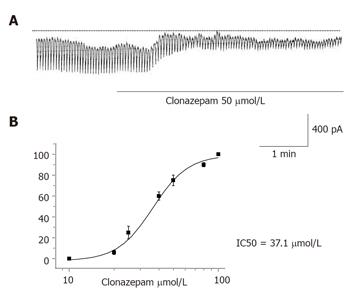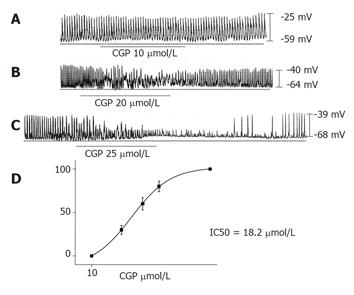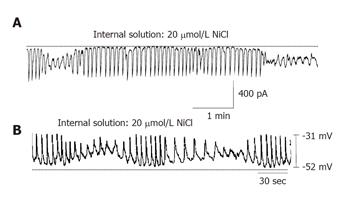Copyright
©2006 Baishideng Publishing Group Co.
World J Gastroenterol. Feb 7, 2006; 12(5): 796-799
Published online Feb 7, 2006. doi: 10.3748/wjg.v12.i5.796
Published online Feb 7, 2006. doi: 10.3748/wjg.v12.i5.796
Figure 1 The effect of clonazepam on the pacemaking activity of ICCs.
Clonazepam was applied to examine its effect on the pacemaking activity of ICCs. A: Under a voltage clamp at a holding potential of –60 mV, 50 µmol/L clonazepam inhibited the pacemaking currents of ICCs (n = 4). B: Clonazepam from 20 to 60 µmol/L effectively inhibited Ca2+ efflux from mitochondria in the pacemaking activity of ICCs. The IC50 of clonazepam was 37.1 µmol/L.
Figure 2 The effect of CGP37157 in the pacemaking activity of the ICCs.
CGP37157 was applied to examine its effect on the pacemaking activity of ICCs. A, B, and C: Under a current clamp (I = 0), CGP37157 inhibited the pacemaking potentials in a dose-dependent manner (n = 15). D: CGP37157 from 10 to 30 µmol/L effectively inhibited Ca2+ efflux from mitochondria in the pacemaking activity of ICCs. The IC50 of CGP37157 was 18.2 µmol/L.
Figure 3 Effect of internal Ni2+ on the pacemaking activity of ICCs.
In order to investigate the effect of NiCl2 on the pacemaking activity of ICCs, we added 20 µmol/L of NiCl2 to the internal solution. A: Under a voltage clamp at a holding potential of -60 mV, the pacemaking activity of ICCs showed a “wax and wane” phenomenon (n = 6). B: Current clamp mode (I = 0) showed the same phenomenon (n = 3).
- Citation: Kim BJ, Jun JY, So I, Kim KW. Involvement of mitochondrial Na+–Ca2+ exchange in intestinal pacemaking activity. World J Gastroenterol 2006; 12(5): 796-799
- URL: https://www.wjgnet.com/1007-9327/full/v12/i5/796.htm
- DOI: https://dx.doi.org/10.3748/wjg.v12.i5.796











